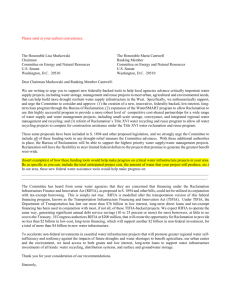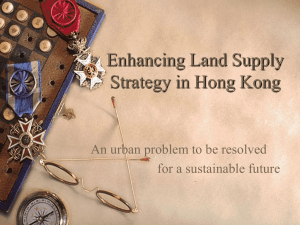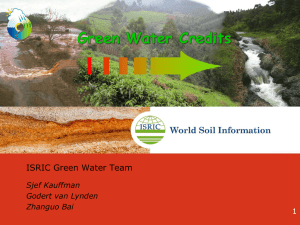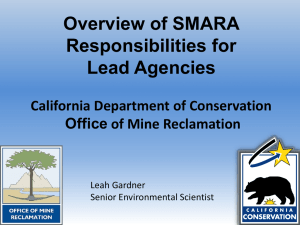Module 18: Land Use/Reclamation/Fish and Wildlife
advertisement
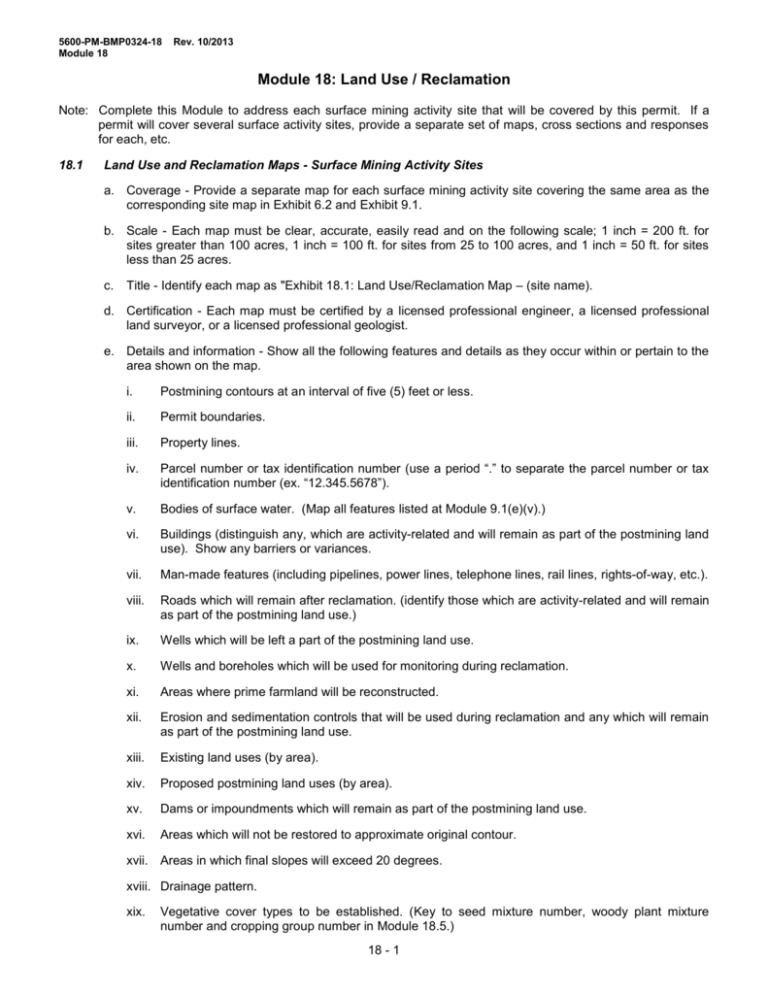
5600-PM-BMP0324-18 Module 18 Rev. 10/2013 Module 18: Land Use / Reclamation Note: Complete this Module to address each surface mining activity site that will be covered by this permit. If a permit will cover several surface activity sites, provide a separate set of maps, cross sections and responses for each, etc. 18.1 Land Use and Reclamation Maps - Surface Mining Activity Sites a. Coverage - Provide a separate map for each surface mining activity site covering the same area as the corresponding site map in Exhibit 6.2 and Exhibit 9.1. b. Scale - Each map must be clear, accurate, easily read and on the following scale; 1 inch = 200 ft. for sites greater than 100 acres, 1 inch = 100 ft. for sites from 25 to 100 acres, and 1 inch = 50 ft. for sites less than 25 acres. c. Title - Identify each map as "Exhibit 18.1: Land Use/Reclamation Map – (site name). d. Certification - Each map must be certified by a licensed professional engineer, a licensed professional land surveyor, or a licensed professional geologist. e. Details and information - Show all the following features and details as they occur within or pertain to the area shown on the map. i. Postmining contours at an interval of five (5) feet or less. ii. Permit boundaries. iii. Property lines. iv. Parcel number or tax identification number (use a period “.” to separate the parcel number or tax identification number (ex. “12.345.5678”). v. Bodies of surface water. (Map all features listed at Module 9.1(e)(v).) vi. Buildings (distinguish any, which are activity-related and will remain as part of the postmining land use). Show any barriers or variances. vii. Man-made features (including pipelines, power lines, telephone lines, rail lines, rights-of-way, etc.). viii. Roads which will remain after reclamation. (identify those which are activity-related and will remain as part of the postmining land use.) ix. Wells which will be left a part of the postmining land use. x. Wells and boreholes which will be used for monitoring during reclamation. xi. Areas where prime farmland will be reconstructed. xii. Erosion and sedimentation controls that will be used during reclamation and any which will remain as part of the postmining land use. xiii. Existing land uses (by area). xiv. Proposed postmining land uses (by area). xv. Dams or impoundments which will remain as part of the postmining land use. xvi. Areas which will not be restored to approximate original contour. xvii. Areas in which final slopes will exceed 20 degrees. xviii. Drainage pattern. xix. Vegetative cover types to be established. (Key to seed mixture number, woody plant mixture number and cropping group number in Module 18.5.) 18 - 1 5600-PM-BMP0324-18 Module 18 Rev. 10/2013 xx. Excess spoil disposal areas. xxi. Facilities for protection or enhancement of fish and wildlife. xxii. Oil and gas wells. (Show barriers and variance areas.) xxiii. Cemeteries. xxiv. Areas where biosolids or coal ash will be applied as soil amendments. xxv. Identify the cross section lines (key to Module 18.2). xxvi. Soil borrow areas. xxvii. Wetland replacement sites. xxviii. Depict aquatic and terrestrial enhancements measures. 18.2 Cross Sections Provide a set of cross sections illustrating the extent of surface disturbance and regrading which will occur at the site. Title the cross sections "Exhibit 18.2 - Cross Sections - [Site Name]." The cross sections must show the original ground surface, the surface as it will appear during active operations, and the surface as it will appear following reclamation. At least one cross section must also be provided for each area where the original ground surface or final graded surface will exceed 20 degrees. (Cross sections need not be provided for coal refuse disposal areas, if construction drawings showing similar details are provided under Module 21.) 18.3 18.4 18.5 Reclamation Plan a. Provide detailed site reclamation plans and include designs for any additional erosion and sedimentation contol structures in Module 11. b. Describe the measures, which will be taken during the reclamation and post mining phase of operations to minimize disturbances and adverse impacts to fish, wildlife, and related environmental values and achieve enhancement of resources where practible. If enhancement measures are not proposed, explain why enhancement is not practical. Pre-mining Land Use a. Identify the present uses of each land use area within the permit area. If the use of the land has changed within the last five (5) years, also identify the use of the land prior to the change. If the land has been previously mined, identify the use before it was mined. (Key land uses to Exhibit 18.1.) b. Giving consideration to soil and foundation characteristics, topography, vegetative cover, and the hydrology of the area, identify other uses each land use area is capable of supporting. c. For any cropland, pastureland or land occasionally cut for hay or commercial forest; identify the productivity expressed as average yield of food, fiber, forage or wood products. Use yield data or estimates for similar sites based on current data from the U.S. Department of Agriculture or Pa. Department of Agriculture. d. For land within and adjacent to the permit area, identify existing land uses and land use classifications under local law. e. Describe the characteristics (e.g. thickness, erodability, and drainage) of each soil type present within the area to be affected by surface mining activities. Postmining Land Use a. For each premining land use area in Module 18.4, identify the postmining land use to which the land will be restored, how each land use is to be achieved and the necessary support activities which may be needed to achieve the land use. In addition, if the postmining land use is pastureland, describe the detailed management plans to be implemented. (Key the postmining land uses to Exhibit 18.1) 18 - 2 5600-PM-BMP0324-18 Module 18 Rev. 10/2013 b. For each premining land use area in Module 18.4, discuss the manner in which other potential uses under Module 18.4(b) were considered in determining the selected postmining land use. Include consideration given to surface owner plans, and applicable state and local land use plans and programs. c. Identify each building, road, impoundment, or other structure which will be developed, improved, or used under this permit and which will remain following reclamation. Also describe its role in the postmining land use. i. For each impoundment that will remain, provide information to demonstrate that: the quality of impounded water will be suitable for the intended use; the level of water and size of impoundment will be sufficient to support the intended use; the impounded water will be safely accessible; adjacent water supplies will not be adversely impacted; and the impoundment will be compatible with the postmining land use. d. Indicate whether or not the proposed land use is compatible with local zoning and land use restrictions. e. Provide the comments concerning proposed land uses from the legal or equitable owner of the land surface. f. If an alternative land use is proposed, provide the following information: i. A notarized written statement from the owner of the surface (landowner) requesting that the alternative land use be approved and including his comments. ii. A description of the land uses in the surrounding area. iii. The written comments of the government agency or planning commission with statutory responsibilities for land use policies and plans. iv. Any zoning or land use ordinance approval. v. Plans showing the feasibility of the alternative land use related to projected land use trends and markets, and a schedule showing how the proposed use will be developed and achieved. vi. If land or buildings are being dedicated to a public agency to be used for public facilities, a letter of commitment from the agency. vii. Documentation showing that the alternative land use will be practicable with respect to private financial capability for completion of the proposed use. viii. Plans to ensure the stability, drainage, and configuration necessary for the intended use of the site. ix. Measures to mitigate adverse effects on fish, wildlife, and related environmental values. 18.6 Revegetation Soil Test Plan a. Provide a soil test plan for determining plant nutrients and soil amendments required to establish vegetation and achieve the approved postmining land use. b. Temporary Cover - Provide the following information for each seed mixture to be used for temporary cover: (Note: Key to Exhibit 18.1) i. Seed Mixture No. Seed Mixture (Species) Rate of Appl. (lbs./acre) 18 - 3 Seed Quality (Min. % Germ.) (Min. % Purity) 5600-PM-BMP0324-18 Module 18 ii. Rev. 10/2013 Use. iii. Method(s) of seeding. iv. How seedbed will be prepared for planting. v. c. Type(s) of mulch to be used and rate(s) of application. Permanent Cover. Provide the following information for each seed mixture to be used for permanent cover: (Note: Key to Exhibit 18.1) i. ii. Seed Mixture No. Seed Mixture (Species) Rate of Appl. (lbs./acre) Seed Quality (Min. % Germ.) (Min. % Purity) Use. iii. Method of seeding. iv. How seedbed will be prepared for planting. v. d. Type(s) of mulch to be used and rate(s) of application. Woody Plants. For areas that will also be planted with woody plants, provide the following: (Note: Key to Exhibit 18.1) i. Woody Plant Mixture No. ii. Method of planting. Woody Plant Species No./ac. iii. If the area is to be planted for wildlife habitat, identify the grouping and distribution of the plants and the type of wildlife habitat to be created. 18 - 4 5600-PM-BMP0324-18 Module 18 Rev. 10/2013 e. Cropland. For areas that will be planted to crops (agronomic or horticultural), identify the crops to be grown and the management plans to achieve the crop yield standards. (Note: Key to Exhibit 18.1) f. Measurement Techniques. Specify the technique to be used to evaluate the success of revegetation. If cropland is the proposed postmining land use, specify the technique for determining crop yields. Describe the remedial measures to be employed should the minimum standards of success for reclamation not be initially met. 18 - 5

